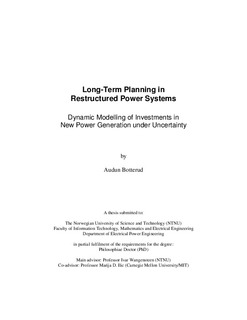| dc.contributor.author | Botterud, Audun | nb_NO |
| dc.date.accessioned | 2014-12-19T11:20:03Z | |
| dc.date.available | 2014-12-19T11:20:03Z | |
| dc.date.created | 2003-12-18 | nb_NO |
| dc.date.issued | 2003 | nb_NO |
| dc.identifier | 125305 | nb_NO |
| dc.identifier.isbn | 82-471-5662-8 | nb_NO |
| dc.identifier.uri | http://hdl.handle.net/11250/227955 | |
| dc.description.abstract | This thesis describes the development of three decision support models for long-term investment planning in restructured power systems. The model concepts address the changing conditions for the electric power industry, with the introduction of more competitive markets, higher uncertainty and less centralised planning. Under these circumstances there is an emerging need for new planning models, also for analyses of the power system in a long-term perspective. The thesis focuses particularly on how dynamic and stochastic modelling can contribute to the improvement of decision making in a restructured power industry. We argue that the use of such modelling approaches has become more important after the introduction of competitive power markets, due to the participants’ increased exposure to price fluctuations and economic risk. Our models can be applied by individual participants in the power system to evaluate investment projects for new power generation capacity. The models can also serve as a decision support tool on a regulatory level, providing analyses of the long-term performance of the power system under different regulations and market designs.
In Chapter 1, we give a brief introduction to the ongoing development towards restructuring and liberalisation of the electrical power system. A discussion of the operation and organisation of restructured power systems is also provided. In Chapter 2, we look more specifically at different modelling approaches for expansion planning in electrical power systems. We also discuss how the contributions in this thesis compare to previous work in the field of decision support models for long-term planning in both regulated and competitive power systems. In Chapter 3, we develop a power market simulation model based on system dynamics. The advantages and limitations of using descriptive system dynamics models for long-term planning purposes in this context are also discussed. Chapter 4 is devoted to a novel optimisation model which calculates the optimal investment strategy for a profit maximising investor considering investments in new power generation capacity. The model is based on real options theory, which is an alternative to static discounted cash flow evaluations of investments projects under uncertainty. In the model we represent load growth as a stochastic variable. A stochastic dynamic programming algorithm is applied in order to solve the investment problem. Prices and profits are calculated in a separate model, whose parameters can be estimated based on historical data for load, prices and installed capacity in the power system. In Chapter 5, we extend the stochastic dynamic optimisation model from Chapter 4, so that the investor now can choose between two different power generation technologies to invest in. An alternative representation of the power market is also implemented, which makes it possible to use either a profit or a social welfare objective in the optimisation. With this model we can compare the optimal investment decisions, and the dynamics of investments, prices and reliability, which follow from centralised and decentralised decision making.
The main scientific contributions in the thesis lie in the combined use of economic theory for restructured power systems and theory for optimal investments under uncertainty. With an explicit representation of the power market, the dynamic investment models can identify profit maximising investment strategies under different regulations and market designs. The use of physical state variables in the models also facilitates analyses of the long-term consequences for the power system, which result from the optimal decentralised investment decisions. Decision support models for expansion planning in the regulated power industry do not address the aspect of competition and decentralised decision making. At the same time, long-term uncertainties and their impact on optimal investment decisions are rarely represented in planning models for the competitive industry. The stochastic dynamic models in this thesis therefore provide a new framework for long-term analysis of investments and prices in restructured power systems.
Potential applications of the investment models are demonstrated in a number of illustrative examples in the thesis. Through the analyses in these examples we have gained increased insight into the complex dynamics of prices, investments and security of supply in competitive power systems. | nb_NO |
| dc.language | eng | nb_NO |
| dc.publisher | Fakultet for informasjonsteknologi, matematikk og elektroteknikk | nb_NO |
| dc.relation.ispartofseries | Dr. ingeniøravhandling, 0809-103X; 2003:106 | nb_NO |
| dc.relation.haspart | Botterud, A; Bhattacharyya, AK; Ilic, M. Futures and spot prices - an analysis of the Scandinavian electricity market. . | nb_NO |
| dc.relation.haspart | Botterud, A. Alternatives for sustainable energy supply in Scandinavia. . | nb_NO |
| dc.relation.haspart | Botterud, A; Ilic, M; Wangensteen, I. Optimization of generation investmens under uncertainty in restructured power markets. . | nb_NO |
| dc.title | Long Term Planning in Restructured power Systems: Dynamic Modelling of Investments on New Power Generation under Uncertainty | nb_NO |
| dc.type | Doctoral thesis | nb_NO |
| dc.source.pagenumber | 197 | nb_NO |
| dc.contributor.department | Norges teknisk-naturvitenskapelige universitet | nb_NO |
| dc.description.degree | PhD i informasjons- og kommunikasjonsteknologi | nb_NO |
| dc.description.degree | PhD in Information and Communications Technology | en_GB |
